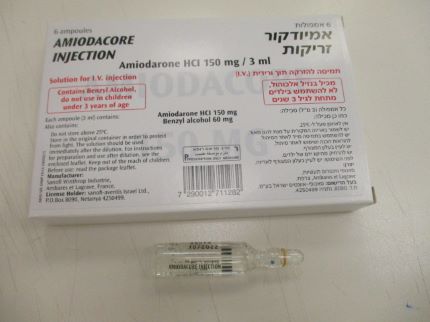Quest for the right Drug

אמיודקור זריקות AMIODACORE INJECTION (AMIODARONE HYDROCHLORIDE)
תרופה במרשם
תרופה בסל
נרקוטיקה
ציטוטוקסיקה
צורת מתן:
תוך-ורידי : I.V
צורת מינון:
תמיסה להזרקה : SOLUTION FOR INJECTION
עלון לרופא
מינוניםPosology התוויות
Indications תופעות לוואי
Adverse reactions התוויות נגד
Contraindications אינטראקציות
Interactions מינון יתר
Overdose הריון/הנקה
Pregnancy & Lactation אוכלוסיות מיוחדות
Special populations תכונות פרמקולוגיות
Pharmacological properties מידע רוקחי
Pharmaceutical particulars אזהרת שימוש
Special Warning עלון לרופא
Physicians Leaflet
Adverse reactions : תופעות לוואי
4.8 Undesirable effects The following adverse reactions are classified by system organ class and ranked under heading of frequency using the following convention: very common (≥ 10%), common (≥ 1% and < 10%); uncommon (≥ 0.1% and < 1%); rare (≥ 0.01% and < 0.1%), very rare (< 0.01%), not known (cannot be estimated from the available data). Blood and lymphatic system disorders: In patients taking amiodarone there have been incidental findings of bone marrow granulomas. The clinical significance of this is unknown. Frequency not known: neutropenia,agranulocytosis Cardiac disorders: Common: bradycardia, generally moderate. Very rare: • marked bradycardia, sinus arrest requiring discontinuation of amiodarone, especially in patients with sinus node dysfunction and/or in elderly patients. • onset of worsening of arrhythmia, sometimes followed by cardiac arrest (see sections 4.4 and 4.5). Frequency not known: torsade de pointes (see 4.4 and 5.1). Eye disorders: Frequency not known: optic neuropathy/neuritis that may progress to blindness (see section 4.4). Endocrine disorders: Very rare: Syndrome of inappropriate antidiuretic hormone secretion (SIADH) Frequency not known: hyperthyroidism (see section 4.4). Gastrointestinal disorders: Very rare: nausea Pancreatitis/ acute pancreatitis General disorders and administration site conditions: Common: injection site reactions such as pain, erythema, oedema, necrosis, extravasation, infiltration, inflammation, induration, thrombophlebitis, phlebitis, cellulitis, infection, pigmentation changes. Hepatobiliary disorders: Very rare: • isolated increase in serum transaminases, which is usually moderate (1.5 – 3 times normal range) at the beginning of therapy. They may return to normal with dose reduction or even spontaneously. • acute liver disorders with high serum transaminases and/or jaundice, including hepatic failure, sometimes fatal (see section 4.4). Immune system disorders: Very rare: anaphylactic shock. Frequency not known: angioneurotic oedema (Quincke's Oedema) Musculoskeletal and connective tissue disorders: Frequency not known: Back pain Nervous system disorders: Very rare: benign intra-cranial hypertension (pseudo tumor cerebri), headache. Respiratory, thoracic and mediastinal disorders: Very rare: • interstitial pneumonitis or fibrosis, sometimes fatal (see section 4.4). • severe respiratory complications (adult acute respiratory distress syndrome), sometimes fatal (see sections 4.4 and 4.5). • bronchospasm and/or apnoea in case of severe respiratory failure, and especially in asthmatic patients. Psychiatric disorders Common: Libido decreased Frequency not known: Confusional state/delirium, hallucination Skin and subcutaneous tissue disorders: Common: eczema Very rare: sweating Frequency not known: urticaria, severe skin reactions sometimes fatal including toxic epidermal necrolysis/Stevens- Johnson syndrome, bullous dermatitis and Drug Reaction with Eosinophilia and Systematic Symptoms. Vascular disorders: Common: decrease in blood pressure, usually moderate and transient. Cases of hypotension or collapse have been reported following overdosage or a too rapid injection. Very rare: hot flushes Injury, poisoning and procedural complaints: Not known: primary graft dysfunction post cardiac transplant (see section 4.4). Reporting of suspected adverse reactions Reporting suspected adverse reactions after authorisation of the medicinal product is important. It allows continued monitoring of the benefit/risk balance of the medicinal product. Any suspected adverse events should be reported to the Ministry of Health according to the National Regulation by using an online form https://sideeffects.health.gov.il

שימוש לפי פנקס קופ''ח כללית 1994
Ventricular & supraventricular arrhythmias not responding to other treatments, tachyarrhythmias associated with Wolff-Parkinson-White syndrome
תאריך הכללה מקורי בסל
01/01/1995
הגבלות
תרופה מוגבלת לשימוש בבתי חולים או אשפוז יום
מידע נוסף
